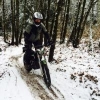-
Posts
166 -
Joined
-
Last visited
Contact Methods
-
AIM
tsiklonaut
-
Skype
tsiklonaut
Contact Information
Recent Profile Visitors
|
3,674 profile views
|
-
I really like the Mitani sidestand solution on 4RT myself, as light as a feather yet the bike stands like a rock stable on it, nothing fiddly about it, even on a softer ground. Also goes more nicely "out of the way" without being vunerable and works partly as a swingarm protection too compared to other sidestand mods I've seen on Montesas - it's vastly superior IMHO. (Accordingly) not cheap though!
-
Cheers guys, looks like ideas worth exploring. I've already put some transparent tape on and mapped out the "hot zone" (bottom of the Termignoni carbon fibre lump). Will see how this holds up and if not, then I'll seek into Mitani solution. Thanks again!
-
Just seeing that part of Termignoni exhaust turning mat where my leg touches it off the footpeg - in dirty conditions my boots will work like a sandpaper against that carbon-fibre surface wearing it down. I wonder has anybody found a way to protect this part, some heat-resistant sticker to put on maybe? Cheers, Margus
-
I've also searched for this - I don't think there's much detailed info on the Showa rear shock overhaul. I know people send them to suspension specialists for rebuild (clean, new oil, new seals, repressure). Getting it defleated and rebuild is probably doable by someone who's done shocks before with the right tools - would be nice if anyone with experience can DIY and make a good video on that Showa shock. Still, you probably need a suspension technician who can re-pressuriurize the shock after rebuild(?)
-

ossa tri 2013 rebuild engine runs with resistance
tsiklonaut replied to Paulfromholland's topic in OSSA
Be sure the pin-locked crank bearing was fixed correctly (pin screw to the bearing's groove). If the pin doesn't hold it, once the engine heats up and metal expands the crank can drift w/o mechanical lock with pin - thus with a "drifting" crankshaft some of the crank sides (magneto or other side) can contact the crankcase at the extremes. -
It's a decent advice, will definitely do it more often to keep them lubed and fresh. I reckon it depends how much you ride in dirt and water, or in very hot conditions, that'd shorten the required relubing interval dramatically.
-
Thanks for the info. Got the Allballs kit. The slack is quite noticable. Started to work on it, visually the linkage looks allright: In the end took me couple of hours actually, since they were like crap so I did it properly. See how bad they looked inside - completely dry and done: Cleaned and relubed the swingarm bearings as well, they were allright, smooth and tight, with no slack what so ever: The dog bone has gotten a little bump so the bearings didn't come out and went in that easy. Got to work it, but the bearing to bushing was a bit tighter compared to others so I probably have to get a new dog bone someday. The final collection of old bearings and bushings give a good indication how bad they were: After installing the new bearings and bushings I noticed the bike immediately is transformed. Rear end is sharp and bouncy, I now have to reduce rebound quite a bit since it was adjusted to that bad linkage movement. My rear end now flyes up considerably easier on rear-end lifted turns and takes landing from jumps considerably smoother. As I said, the bike really transformed. Hence this work was long overdue and I am glad I did it. Hence if you have similar slack - you ought to check the linkage.
-
I made the spiked tyres myself. I bought some screw-in stud/spike kit some years ago, can't remember where I bought it but just using an electric drill with correct size socket and screwed them in the trials rubber knobs, with a pattern as I see fit. (To every knob maybe a bit overkill unless you're on ice all the time). If you get the screw-in type spykes, be careful with front tyre though since they tend to come through a bit and can puncture front innter tube. I put couple of rounds of duct tape on the inside of the front tyre to fix this, so those few spikes that penetrate the tyre stick into tape first before damaging inner tube. Beware trials tyres are soft, hence don't push or stop the bike too agressively on hard surfaces - or you'll lose lots of those studs . But on ice and snow you can quite push it no problem.
-
Bought a nice s/h 2016 4RT Repsol. One thing I noticed there's a bit slack in the rear likage, so I reckon I need to replace those bearings to make it tight and smooth again. Anyone done it, any pointers what replacement parts to order, Allballs kit?
-
Very nice Beta there, they are built strong like bricks! I've also found winter's nice riding, but with a lightweight bike like the radical OSSA (TR280i in my case). Superb overall bike design for it - no radiator in front to damage or clog up, no hot exhaust pipe to burn you up when you fall down and get stuck under the bike - can happen a lot more in icy and snowy conditions. For summer I use "sharper" maps then for winter I loaded "softer" EFI maps into OSSA brain so with those it tracks very well on snow and ice, with the correct mapping it gives superb traction in the slippery stuff in fact. Pics from previous winters:
-

EFI OSSA Notebook (Formerly TR280i Wiring Diagram Annotated in English)
tsiklonaut replied to konrad's topic in OSSA
Big thanks Konrad, It's a great research and info! Will save the doc for sure. Interesting about the idle vs starting ease. I've found when I set the idle around 1450-1500rpm I gets a bit easier start. Adjusting idle isn't so hard when you have the diagnostic plug to compensate & reset the TPS when you open up the butterfly a little for more rpms. Still, air bypass sounds like a great idea. -
2-5 kicks on cold start, 3-4 average. Mostly 1 kick with warm engine, sometimes 2 when I don't give sharp enough kick in some tricky balancing place. I have the 2013 TR280i wich is the super-high compression engine (even more compression than the red OSSA racing head sold separately so mine is VERY hard to kick!) and I don't have any batterypack start assist anymore, found it helped just a little but created lots of fuss with wires and battery weight. I've found those factors to look for on easier start that makes the start assist battery pack not a requirement: -correct TPS voltage and a bit higher idle (and I've tuned 50-100rpm higher than OSSA manual recommends) -it's important to keep the stator side chamber very clean (so it generates a good voltage, good practice is to pull off the magneto time-to-time and clean the inners) -a flywheel weight I have helps on starting too -on cold 1st and often 2nd kick are to get the capacitor full (it steals all the voltage then, so don't waste your energy too much on first kicks hoping it makes it better but actually it doesn't help much, I give 60-70% of my kicking power just to get some voltage into capacitor first), then on 3nd or 4rd kick the capacitor fires the volts out and starts on nice sharp kick (when warm the capacitor is full anyways, so 1st kick start most of the time)
-
I'm on holidays for 3 weeks so can't UL for you now. But for future helps, since there's no OSSA support anymore, I or anybody else who has it here should U/L the software somewhere for those who need it? The software is required to set the TPS which should be done at least once a season to keep your TR-i in perfectly tuned running condition IMHO
-
I also use the flywheel weight - really like it. I've had the same problem before, very easy to fix when you have the diagnostics plug. You need to re-set the idle via adjusting the throttle body butterfly opening. Ideally clean TB before too (there's an air hole in the butterfly that can get clogged with oil in time and the idle drops), but not mandatory since you can adjust it with TB butterfly opening anyway. The problem is when you change the idle you need to set the TPS zero point to 0.6V again so the EFI has the correct zero point for the smooth mapping translation. Do you have the diagnostic plug and software?
-
I just fitted as it was. Now thinking about it I think that way it's more correct: 1) there will be some pressure from the oil pouring in from the channels, fitting the spring side away from oil will cause a leak sooner or later (I've made this mistake on forks, they leak every time you do this!) 2) when installing the "other way round" you'll likely damage the seal on installing it (kicking it in from the spring side is a bad idea!)





